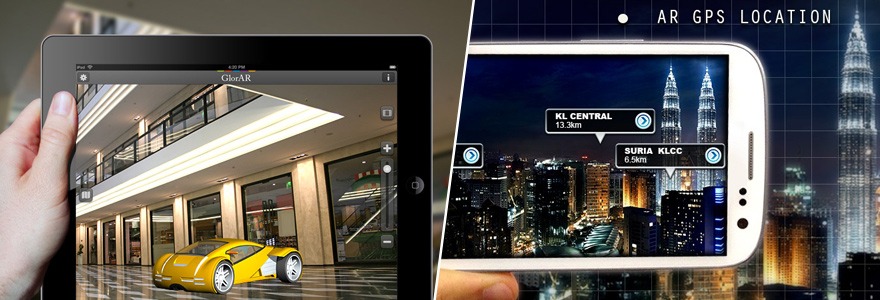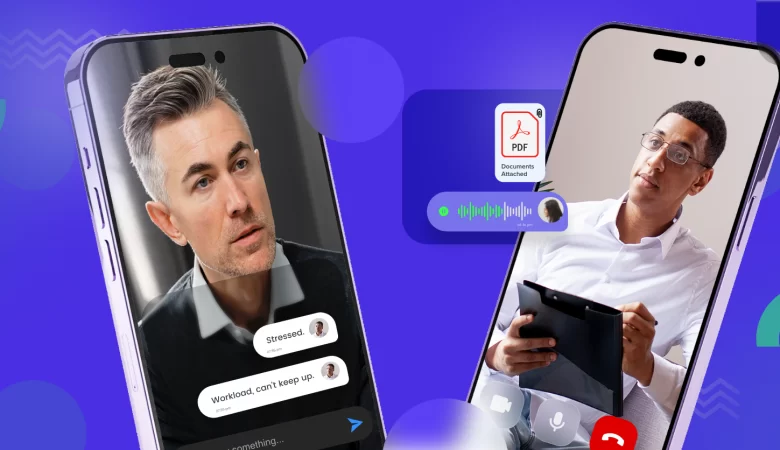Augmented Reality in mobile apps, an adaptation which sounds like a futuristic one is now an industry trend and not so far from becoming common.
Creating a virtual experience in the real world is what AR aims at. This aspect can be used by augmented reality app development companies to help businesses build AR apps to improve the way they project their products or services to consumers.
Techcrunch – AR/VR could hit $150B revenue by 2020, with AR taking the lion’s share of around $120B & VR at $30B. https://t.co/ffpKcQjixk — Contus (@contus) April 6, 2016
Intrigued by this fact?? Then it is time to know in depth about this technology, how to develop AR apps in iOS, Android and other platforms, how viable it is and the possibilities of making it operative for business benefits.
Table of Contents
How Augmented Reality Technology Works?
Augmented reality uses two approaches, marker based and location based.

Maker Based concept is about having a software recognize a pattern (a symbol or sign) when a camera scans it and projecting a digital content like image or video on the surface of the symbol or sign.
Location based approach is mainly for navigational purposes where a user’s location is identified and after recording the current location of the user’s device data like a navigational map or information on the surrounding places are provided.
What it is Like to Experience Augmented Reality?
 Augmented reality blurs the line between real and computer generated experiences by placing digitally generated information in (images, visuals, 3D models, walkthroughs, videos) in user’s real world. It helps experience or learn things though it happens to be a smart illusion.
Augmented reality blurs the line between real and computer generated experiences by placing digitally generated information in (images, visuals, 3D models, walkthroughs, videos) in user’s real world. It helps experience or learn things though it happens to be a smart illusion.
Augmented reality and how it takes on device fragmentation
Augmented reality is not completely reserved for wearable devices like Google Glass, Go gears, Smart TV or those which cannot be a part of everybody’s day-to-day use rather it can be put to use in mobile devices like smartphones, tablets via platforms like iOS, Android, Windows etc.
When it comes to AR based mobile app development services, it can play a major role in app sectors like enterprise apps, advertising, education, consumer apps, mobile app gaming etc.
Why Should Businesses Develop Augmented Reality Apps?
Yes, you’re guessing it right. Augmented reality is going to be next step for businesses in terms of spicing up their customer experiences and stay ahead of their competitors, especially in retail e-commerce. On the flip side, the investments aren’t going to be too much as AR is more capital friendly.

Branding – Building Augmented reality applications, your brand gets recognized in a flash and most importantly, creates an impact so that it stays in your target audience mind forever.
User Experience – AR complements the physical shopping experience with a bit of color, sound and visual content. The customer will still be in the most familiar environment and at the same time experiencing something engaging and convincing.
Investments on such graphics aren’t going to be too much as today’s technology have made it much economical ultimately making Augmented Reality a more commercially viable solution.
AR Application in Businesses
![]()
In-Store experience – Simulation of products in actual size in virtual trial rooms fits apparels for customers making in-store shopping more convincing even in the absence of the products.
Online shopping – Demo videos that deliver more information and videos of unboxing products provides a direct store-visit-like experience for shoppers.
AR Maps -Augmented Reality apps with maps can navigate, throw details on places nearby when coupled with technologies like geolocation.
![]()
Travel – Digital walkthroughs of sites and ambiance with historical information, panoramic view of sites.
Education – Augmented reality apps for education can contribute in more engaging classrooms and interactive learning.
How to Develop Augmented Reality Based Mobile Apps?
Developing augmented reality apps in Android and iOS and all other major platforms is certainly possible.
How to build AR Android apps?
Augmented Reality Android apps can be built using the Android SDK as it provides the API for interacting with the camera. For 3D graphics, the Android SDK provides OpenGL support making it simple for developers.
How to build AR iOS apps?
To develop augmented reality apps on iOS, you can make use of Craft SDK. Its APIs helps in pushing new and editing existing AR contents with ease. Videos, 3D models can be uploaded to the media library on the cloud. With Craft’s Augmented Reality creator, you can easily create the content and simply push it to the AR environment. Craft’s cloud image recognition helps in identifying thousands of objects instantly. Analytics helps in measuring the performance of the AR contents.
Apart from Android and iOS (Metaio – under development) SDKs, there are several toolkits available for creating AR apps on smartphones and wearable devices. HandyAR, Vuforia, cardboard, Layar, ARToolKit, LinceoVR, Wikitude, NyARToolkit, SketchUp are some of the augmented reality app development toolkits available in the market.
Why choose Contus as your Augmented Reality app developer?
Here are the factors that distinguish Contus from other players in the field of AR app development.
Customization – AR is evolving and so Contus develops AR apps that can be completely customized thus ensuring that the possibilities for improvisations are endless.
Security – Contus ensures that your AR apps are protected with multiple layers of security thus ensuring your valuable data from being hacked.
Wearables – Contus can get apps developed on emerging new-age devices like Glasses, smart watches, Go gears etc
Owncloud – Apart from adaptive scalability and safety of app data, Contus extends its services to providing the cloud setup that’s appropriate for your app.
Contus’ Experience as a 5-year-old Augmented Reality App Development Company
![]() Lansdowne Pub, a branded native food app built for Boston’s leading restaurant and pub chain Lansdowne uses Augmented reality for improving customer retention.
Lansdowne Pub, a branded native food app built for Boston’s leading restaurant and pub chain Lansdowne uses Augmented reality for improving customer retention.
With an idea to deliver surprise discounts, deals and offers to its customers in an inviting way, the restaurant made use of augmented reality. Restaurant goers need to scan pub related logos or signs upon which an AR aided information will let them know details of the discount.






I need to create augmented reality app for my store, how much does it cost
It is purely based on your requirements. Right from images to high-profile graphics AR can be used to create a variety of engaging visual experiences. So it depends on how you want you AR experience to be designed.
What is difference between AR(Augmented Reality) & VR(Virtual Reality)?
In general, virtual reality immerses a user into virtual world while Augmented reality brings virtual experiences in real world.
AR is a visual experience created as an image, graphics etc. Users can interact with the experience in the environment which is more common to them. Virtual Reality is something which takes a user into a whole new imaginative world.
Can i use string SDK for android AR development?
No, String SDK is only for iOS platform.
Excellent review.
What are the tools to create augmented reality mobile apps?
As we have mentioned in the blog, Android SDK provides the API for interacting with camera. OpenGL support contributes for 3D graphics.
For iOS Craft SDK can be used. Apart from it, Apple is developing its own SDK for building AR based iOS apps. Apple acquired AR company Metaio last year (May, 2015) for this purpose.
Can you create sensor based apps using AR technology?
Yes, we can develop sensor based AR app using Wikitude SDK. It works for both approaches, location based & sensor based.
simple and best thank you, it’s really nice to read this post. Augmented Reality in mobile apps keeps on changing
Thank you for sharing the information about Mobile App. Currently I am reading mobile app related blogs.
how effectively was augmented reality used for lansdowne project?
Augmented reality was used for the purpose of driving user engagement with the restaurant app. We used AR to deliver surprise discounts and special offers while scanning the Lansdowne restaurant relation logos, posters.
What is your AR business values?
Our project strategies are
*Competitive pricing
*proven methodologies
*Confidentially and security
*Expert Developers
*User-friendly and functional apps
*Seamless Communication
*Interactive Mobile app
*Highly functional apps
*Marketing and brand recognition
*Enhanced user experience
*Social interaction
*Improved Usability
*Helps improved ROI
*Reach out to more customers easily
What are the key aspects that forms the basics of 2d Augmented reality?
-Recognition of an image, a symbol, an object, a face or a body
-Space location in real time
-User friendliness
Thanks for such a great post posting here.
And the point which you have covered in this post regarding ~ “How to develop Augmented Reality based mobile apps?” is superb.
Keep updating us like this.
Thanks for such a great post sharing here.
How to start my Augmented Reality android app?
Start your AR android app from here
http://developer.android.com/tools/building/building-studio.html
Do you use cloud for AR?
Yes. The images are modified real time using cloud technology.
What are the widely use SDK’s?
The most popular and widely used SDKs are Vuforia, Layar, ARToolKit, NyARToolkit, LinceoVR, HandyAR, FLARToolKit, AR-media, Google plugins, SketchUp, Junaio and Wikitude.
How to use Android Studio with Vuforia to build AR app?
The update of Vuforia 5.0.10 supports Android Studio, the integrated development environment for Android platform.
How effective to integrate AR with appcelerator titanium?
Yes, Major two features in titanium are,
i) A cross-platform API for accessing native UI components such as navigation bars, menus, and dialog boxes and native device functionality including the file system, network, geolocation, accelerometer, and maps.
ii) Transparent access to native functionality not already covered by the API.
I want to publish my app under AndAR?, is it possible?
Yes, your project is launched under GNU (General public License).
Do I need to use any other software other than those that is showing on the video and adobe air 2.5?
Adobe AIR and Flash are actually running the Flash virtual machine over the Dalvik virtual machine, you might experience performance issues for such a CPU intensive task such as AR.
you an invest in the right company if your services or products are really needed for the targeted audiences.
What is mixed reality?
Mixed Reality is a combination of Augmented Reality and Virtual Reality. Augmented reality brings digital objects into real-world environment while virtual reality immerses users into a whole new digital world.
Mixing up these two technologies to create environment where real and digital objects interact or work together to create new experiences is called mixed reality.
what are the end user touch points of AR?
Desktop based applications, AR in mobile app, AR based ads & promotions, 3D & 2D based animated Objects and Models, AR in gaming and lot more.
What are augmented reality SDKs?
SDKs are those which help in developing augmented reality based applications. Layar and Wikitude – Android. AFAIK, Wikitude and Layar have made their SDKs public. Android Studio provides the SDK for AR apps development. For iOS it is Metaio SDK which has been acquired by Apple now.
I want to know, Who are the top players in augmented reality space?
Tech giants like Google, Facebook, Microsoft, Apple are into refining their own SDKs for developing augmented reality based applications. Google plays with Google Cardboard. Facebook has acquired Oculus VR for $2B USD. Microsoft’s augmented reality are framed using Hololens. Apple acquired Metaio in 2015 to develop it as its own SDK.
Of course Ramanathan! It’s the next step to enhance customer experiences and stay ahead of competitors, especially in retail e-commerce. However, understanding this technology is really challenging, so thanks for your helpful guide.
Thanks for sharing, this blog is very informative and helpful.
Informative article! Keep going Ramanathan!